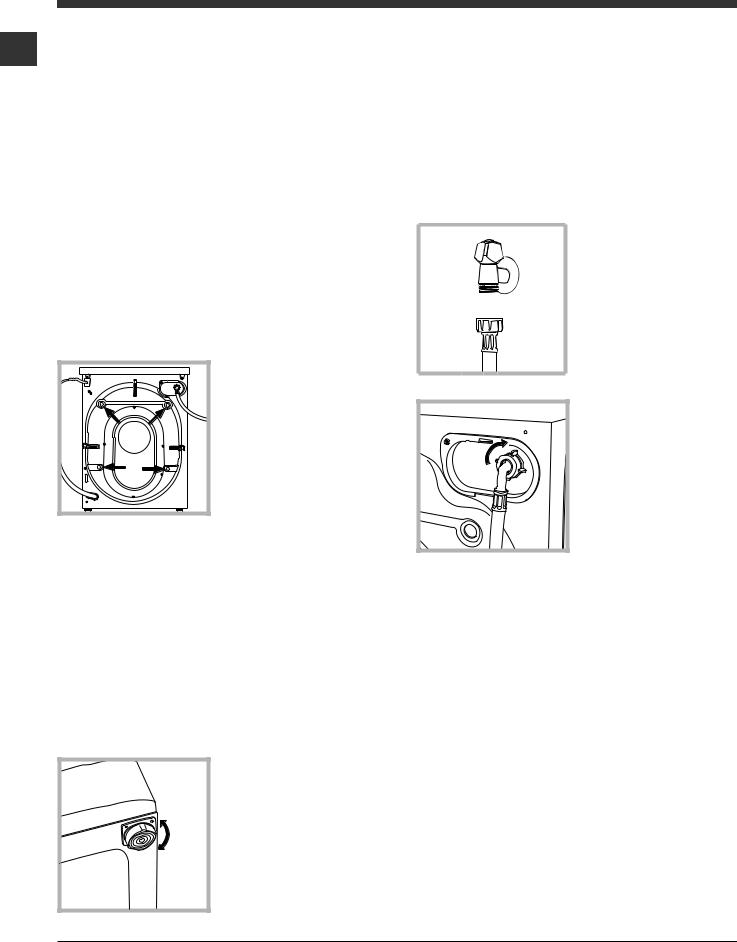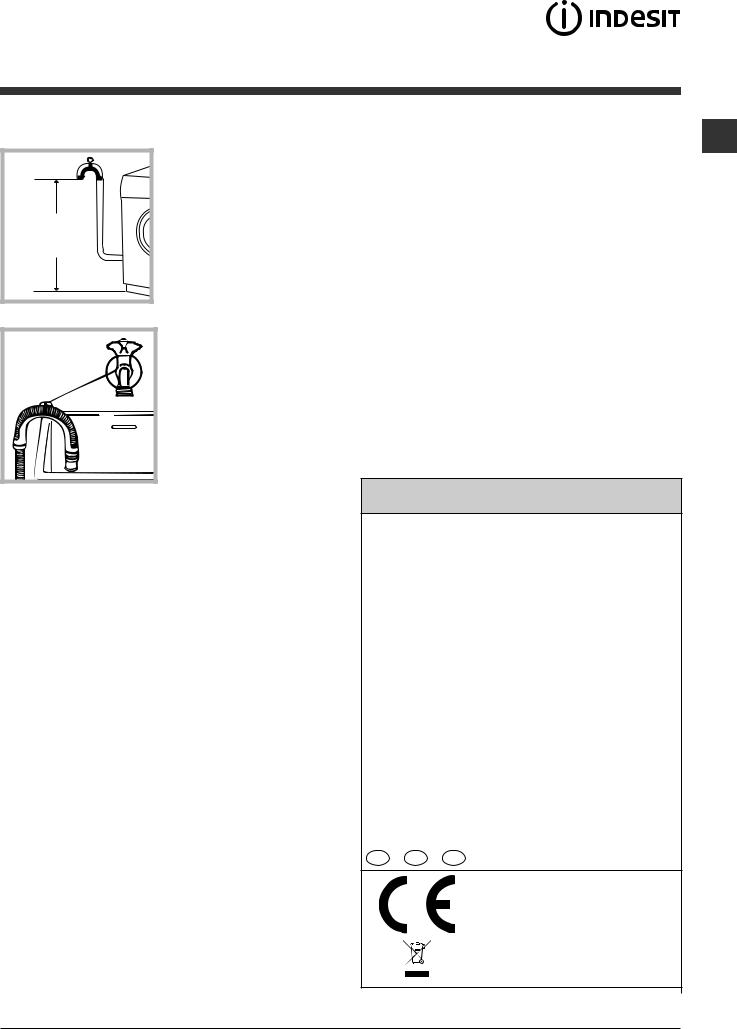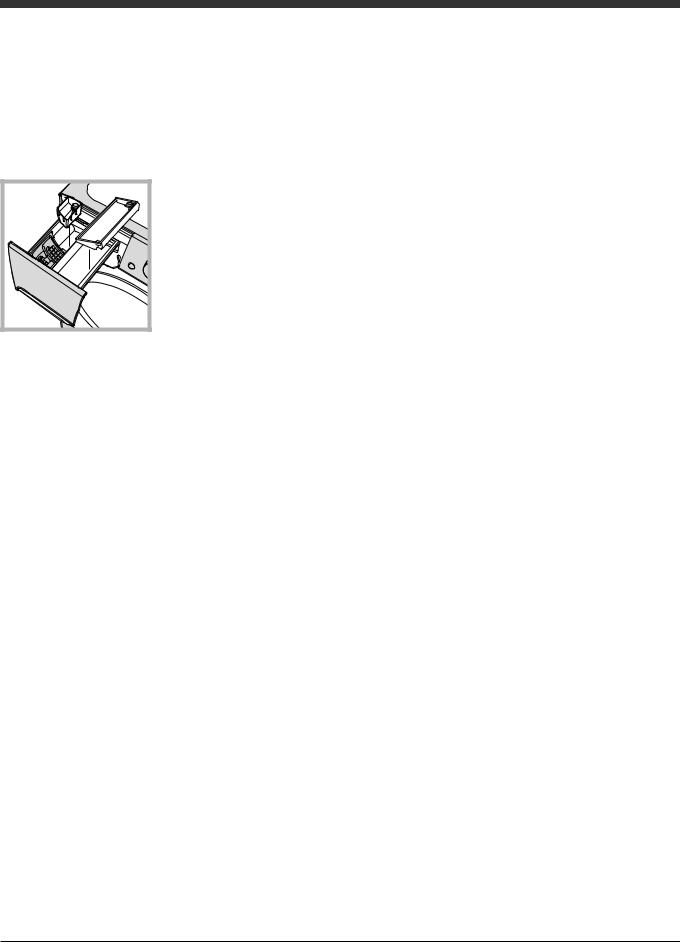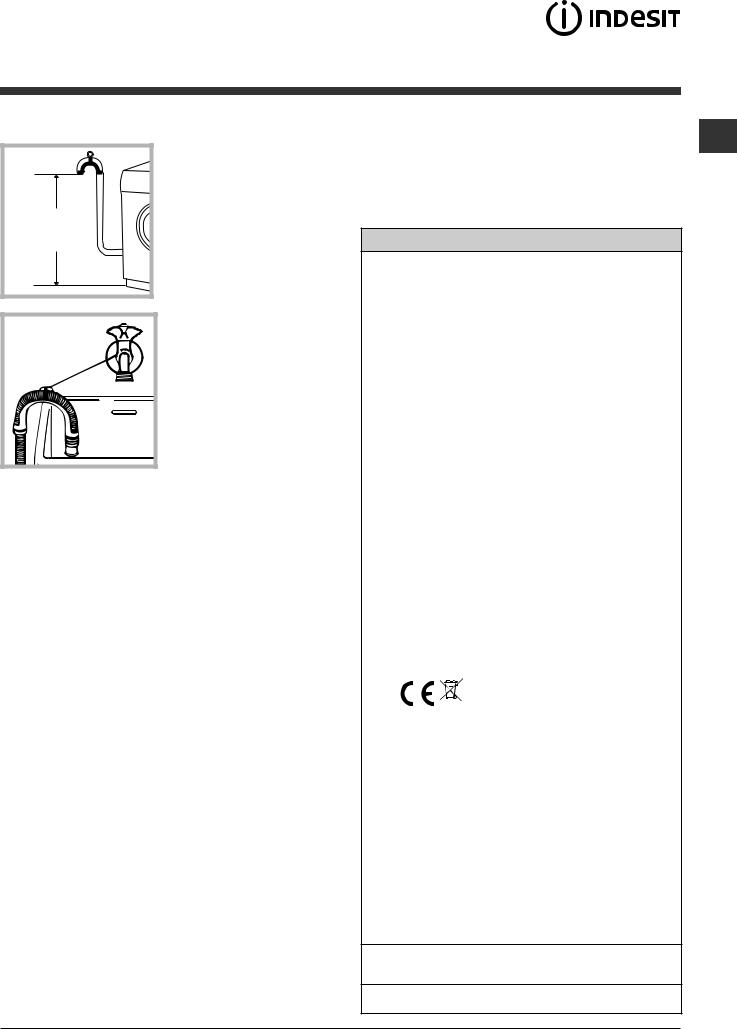Indesit PWSE61070S User Manual

Instructions for use
WASHING MACHINE
GB |
|
CIS |
|
PL |
|
|
|
|
|
|
|
English,1 |
Русский,13 |
Polski,25 |
|||
Contents |
GB |
|
Installation, 2-3
Unpacking and levelling
Connecting the electricity and water supplies
The first wash cycle
Technical data
UK
Українська,37
PWSE 61070 S
Description of the washing machine, 4-5
Control panel Display
Running a wash cycle, 6
Wash cycles and options, 7
Table of programmes and wash cycles
Wash options
Detergents and laundry, 8
Detergent dispenser drawer
Preparing the laundry
Special wash cycles
Precautions and advice, 9
General safety
Disposal
Care and maintenance, 10
Cutting off the water and electricity supplies Cleaning the washing machine
Cleaning the detergent dispenser drawer Caring for the door and drum of your appliance Cleaning the pump
Checking the water inlet hose
Troubleshooting, 11
Service, 12
1

Installation
! This instruction manual should be kept in a safe place for GB future reference. If the washing machine is sold, transferred
or moved, make sure that the instruction manual remains with the machine so that the new owner is able to familiarise himself/herself with its operation and features.
! Read these instructions carefully: they contain vital information relating to the safe installation and operation of the appliance.
Unpacking and levelling
Unpacking
1.Remove the washing machine from its packaging.
2.Make sure that the washing machine has not been damaged during the transportation process. If it has been damaged, contact the retailer and do not proceed any further with the installation process.
3. Remove the 4 protective screws (used during transportation) and the rubber washer with the corresponding spacer, located on the rear part of the appliance (see figure).
4.Close off the holes using the plastic plugs provided.
5.Keep all the parts in a safe place: you will need them again if the washing machine needs to be moved to another location.
! Packaging materials should not be used as toys for children.
Levelling
1. Install the washing machine on a flat sturdy floor, without resting it up against walls, furniture cabinets or anything else.
2. If the floor is not perfectly level, compensate for any unevenness by tightening or loosening the adjustable front feet (see figure); the angle
of inclination, measured in relation to the worktop, must not exceed 2°.
Levelling the machine correctly will provide it with stability, help to avoid vibrations and excessive noise and prevent it from shifting while it is operating. If it is placed on carpet or a rug, adjust the feet in such a way as to allow a sufficient ventilation space underneath the washing machine.
Connecting the electricity and water supplies
Connecting the water inlet hose
1. Connect the inlet hose by screwing it to a cold water tap using a 3/4 gas threaded connection (see figure).
Before performing the connection, allow the water to run freely until it is perfectly clear.
2. Connect the inlet hose to the washing machine by screwing it onto the corresponding water inlet of the appliance, which is situated on the top right-
hand side of the rear part of the appliance (see figure).
3. Make sure that the hose is not folded over or bent.
!The water pressure at the tap must fall within the range of values indicated in the Technical data table (see next page).
!If the inlet hose is not long enough, contact a specialised shop or an authorised technician.
!Never use second-hand hoses.
!Use the ones supplied with the machine.
2

Connecting the drain hose
65 - 100 cm |
Connect the drain hose, without bending it, to a drain duct or a wall drain situated between 65 and 100 cm from the floor;
alternatively, placed it over the edge of a basin, sink or tub, fastening the duct supplied to the tap (see figure). The free end of the hose should not be underwater.
! The cable should not be bent or compressed.
GB
! The power supply cable must only be replaced by authorised technicians.
Warning! The company shall not be held responsible in the event that these standards are not observed.
The first wash cycle
Once the appliance has been installed, and before you use it for the first time, run a wash cycle with detergent and no laundry, using wash cycle number 2.
! We advise against the use of hose extensions; if it is absolutely necessary, the extension must have the same diameter as the original hose and must not exceed 150 cm in length.
Electrical connections
Before plugging the appliance into the electricity socket, make sure that:
•the socket is earthed and complies with all applicable laws;
•the socket is able to withstand the maximum power load of the appliance as indicated in the Technical data table (see opposite);
•the power supply voltage falls within the values indicated in the Technical data table (see opposite);
•the socket is compatible with the plug of the washing machine. If this is not the case, replace the socket or the plug.
!The washing machine must not be installed outdoors, even in covered areas. It is extremely dangerous to leave the appliance exposed to rain, storms and other weather conditions.
!When the washing machine has been installed, the electricity socket must remain within easy reach.
!Do not use extension cords or multiple sockets.
Technical data
Model |
|
PWSE 61070 S |
||
|
|
|
|
|
|
|
|
width 59.5 cm |
|
Dimensions |
|
height 85 cm |
||
|
|
|
depth 44,5 cm |
|
|
|
|
||
Capacity |
|
from 1 to 6 kg |
||
|
|
|
||
Electrical |
|
please refer to the technical data plate |
||
connections |
|
fixed to the machine |
||
|
|
|
|
|
|
|
|
maximum pressure 1 MPa (10 bar) |
|
Water connections |
minimum pressure 0.05 MPa (0.5 bar) |
|||
|
|
|
drum capacity 40 litres |
|
|
|
|
||
Spin speed |
|
up to 1000 rotations per minute |
||
|
|
|
|
|
Test |
Program- |
|
programme 2; |
|
mes according to |
||||
temperature 60°C and 40°C. |
||||
2010/1061 |
|
|||
|
|
|||
|
|
|||
Test Programmes |
|
|||
according to |
|
programme 2; temperature 60°C; |
||
EN 60456 |
|
using a load of 6 kg. |
||
CH |
RU |
TR |
|
|
This appliance conforms to the following
EC Directives:
-2004/108/EC (Electromagnetic Compatibility)
-2006/95/EC (Low Voltage)
- 2002/96/EC
3

|
|
Description of the washing |
|
|
||||
|
|
machine |
|
|
|
|
|
|
|
|
|
|
|
|
|
|
|
|
|
|
|
|
|
|
|
|
|
|
Control panel |
|
|
|
|
|
|
GB |
|
OPTION |
|
|
||||
|
|
|
|
|
|
|||
|
|
|
|
|
DOOR |
|||
|
|
|
|
|
||||
|
|
ON/OFF |
TEMPERATURE |
buttons and |
||||
|
|
indicator lights |
LOCKED |
|||||
|
|
button |
button |
|||||
|
|
|
|
indicator light |
||||
|
|
|
|
|
|
|
||
|
|
|
|
|
|
|
|
|
|
|
|
|
|
|
|
|
|
DISPLAY
|
|
|
|
|
|
|
|
|
|
|
|
|
|
|
|
|
|
WASH |
|
|
DELAYED |
|
|
|
|
SPIN |
|
START |
|
|
|
|
|
|
|
||||
Detergent dispenser drawer |
CYCLE |
button |
|
button |
START/PAUSE |
||
|
|
SELECTOR |
|
|
|
button and indicator |
|
|
|
KNOB |
|
|
|
light |
|
|
|
|
|
|
|||
|
|
|
|
|
|
|
|
Detergent dispenser drawer: used to dispense detergents and washing additives ( see “Detergents and laundry”).
ON/OFF  button: press this briefly to switch the machine on or off. The START/PAUSE indicator light which flashes slowly in a blue colour shows that the machine is switched on. To switch off the washing machine during the wash cycle, press and hold the button for approximately 3 seconds; if the button is pressed briefly or accidentally the machine will not switch off.
button: press this briefly to switch the machine on or off. The START/PAUSE indicator light which flashes slowly in a blue colour shows that the machine is switched on. To switch off the washing machine during the wash cycle, press and hold the button for approximately 3 seconds; if the button is pressed briefly or accidentally the machine will not switch off.
If the machine is switched off during a wash cycle, this wash cycle will be cancelled.
WASH CYCLE SELECTOR KNOB: used to set the desired wash cycle (see “Table of programmes and wash cycles”).
OPTION buttons and indicator lights: press to select the available options. The indicator light corresponding to the selected option will remain lit.
SPIN  button: press to reduce or completely exclude the spin cycle; the value appears on the display.
button: press to reduce or completely exclude the spin cycle; the value appears on the display.
TEMPERATURE 
 button: press to reduce or completely exclude the temperature; the value appears on the display.
button: press to reduce or completely exclude the temperature; the value appears on the display.
DELAYED START  button: press to set a delayed start for the selected wash cycle; the delay period appears on the display.
button: press to set a delayed start for the selected wash cycle; the delay period appears on the display.
START/PAUSE  button and indicator light: when the blue indicator light flashes slowly, press the button to start a wash cycle. Once the cycle has begun the indicator light will remain lit in a fixed manner. To pause the wash cycle, press the button again; the indicator light will flash in an amber colour. If the
button and indicator light: when the blue indicator light flashes slowly, press the button to start a wash cycle. Once the cycle has begun the indicator light will remain lit in a fixed manner. To pause the wash cycle, press the button again; the indicator light will flash in an amber colour. If the  symbol is not illuminated, the door may be opened (wait approximately 3 minutes). To start the wash cycle from the point at which it was interrupted, press the button again.
symbol is not illuminated, the door may be opened (wait approximately 3 minutes). To start the wash cycle from the point at which it was interrupted, press the button again.
DOOR LOCKED  indicator light:
indicator light:
The lit symbol indicates that the door is locked. To prevent any damage, wait until the symbol turns off before opening the door (wait approximately 3 minutes).
To open the door while a cycle is in progress, press the START/PAUSE button; if the DOOR LOCKED  symbol is switched off the door may be opened.
symbol is switched off the door may be opened.
Standby mode
This washing machine, in compliance with new energy saving regulations, is fitted with an automatic standby system which is enabled after about 30 minutes if no activity is detected. Press the ON-OFF button briefly and wait for the machine to start up again.
4

Display |
GB |
|
B
A
C
The display is useful when programming the machine and provides a great deal of information.
The duration of the available wash cycles and the remaining time of a running cycle appear in section A; if the DELAYED START option has been set, the countdown to the start of the selected wash cycle will appear.
Pressing the corresponding button allows you to view the maximum spin speed and temperature values attained by the machine during the set wash cycle, or the values selected most recently, if these are compatible with the set wash cycle. The hour-glass flashes while the machine is processing data, depending on the wash cycle and  level selected. After a maximum of 10 minutes, the “hour-glass” icon remains lit in a fixed manner and the final amount of time remaining is displayed. The hour-glass icon will then switch off approximately 1 minute after the final amount of time remaining has appeared.
level selected. After a maximum of 10 minutes, the “hour-glass” icon remains lit in a fixed manner and the final amount of time remaining is displayed. The hour-glass icon will then switch off approximately 1 minute after the final amount of time remaining has appeared.
The “wash cycle phases” corresponding to the selected wash cycle and the “wash cycle phase” of the running wash cycle appear in section B:
Main wash
Rinse
Spin
Drain
The icons corresponding to “temperature”, “spin” and “delayed start” (working from the left) are displayed in section C. The “temperature” bars 


 indicate the maximum temperature level which may be selected for the set cycle.
indicate the maximum temperature level which may be selected for the set cycle.
The “spin” bars 


 indicate the maximum spin level which may be selected for the set cycle.
indicate the maximum spin level which may be selected for the set cycle.
The “delay” symbol  , when lit, indicates that the set “delayed start” value has appeared on the display.
, when lit, indicates that the set “delayed start” value has appeared on the display.
5

Running a wash cycle
1. SWITCH THE MACHINE ON. Press the  button;
button;
GB the START/PAUSE indicator light will flash slowly in a blue colour.
2.LOAD THE LAUNDRY. Open the porthole door. Load the laundry, making sure you do not exceed the maximum load value indicated in the table of programmes and wash cycles on the following page.
3.MEASURE OUT THE DETERGENT. Pull out the detergent dispenser drawer and pour the detergent into the relevant compartments as described in “Detergents and laundry”.
4.CLOSE THE DOOR.
5.SELECT THE WASH CYCLE. Use the WASH CYCLE SELECTOR knob to select the desired wash cycle. A temperature and spin speed is set for each wash cycle; these values may be adjusted. The duration of the cycle will appear on the display.
6.CUSTOMISE THE WASH CYCLE. Use the relevant buttons:

 Modify the temperature and/or spin speed. The machine automatically displays the maximum temperature and spin speed values set for the selected cycle, or the most recently-used settings if they are compatible with the selected cycle. The
Modify the temperature and/or spin speed. The machine automatically displays the maximum temperature and spin speed values set for the selected cycle, or the most recently-used settings if they are compatible with the selected cycle. The
temperature can be decreased by pressing the  button, until the cold wash “OFF” setting is reached. The spin speed may be progressively reduced by
button, until the cold wash “OFF” setting is reached. The spin speed may be progressively reduced by
pressing the  button, until it is completely excluded (the “OFF” setting). If these buttons are pressed again, the maximum values are restored.
button, until it is completely excluded (the “OFF” setting). If these buttons are pressed again, the maximum values are restored.
 Setting a delayed start.
Setting a delayed start.
To set a delayed start for the selected cycle, press the corresponding button repeatedly until the required delay period has been reached. When this option has been
activated, the  symbol lights up on the display. To remove the delayed start setting, press the button until the text “OFF” appears on the display.
symbol lights up on the display. To remove the delayed start setting, press the button until the text “OFF” appears on the display.





 Modify the cycle settings.
Modify the cycle settings.
•Press the button to enable the option; the indicator light corresponding to the button will switch on.
•Press the button again to disable the option; the indicator light will switch off.
! If the selected option is not compatible with the set wash cycle, the indicator light will flash and the option will not be activated.
!If the selected option is not compatible with a previously selected one, the indicator light
corresponding to the first function selected will flash and only the second option will be activated; the indicator light for the option which has been activated will be illuminated.
Note: if the  option has been selected, none of the incompatible options may be activated.
option has been selected, none of the incompatible options may be activated.
!The options may affect the recommended load value and/or the duration of the cycle.
7.START THE WASH CYCLE. Press the START/ PAUSE button. The corresponding indicator light will turn blue, remaining lit in a fixed manner, and the door
will be locked (the DOOR LOCKED  symbol will be lit). To change a wash cycle while it is in progress, pause the washing machine using the START/PAUSE button (the START/PAUSE indicator light will flash slowly in an amber colour); then select the desired cycle and press the START/PAUSE button again.
symbol will be lit). To change a wash cycle while it is in progress, pause the washing machine using the START/PAUSE button (the START/PAUSE indicator light will flash slowly in an amber colour); then select the desired cycle and press the START/PAUSE button again.
To open the door while a cycle is in progress, press
the START/PAUSE button; if the DOOR LOCKED  symbol is switched off the door may be opened (wait approximately 3 minutes). Press the START/PAUSE button again to restart the wash cycle from the point at which it was interrupted.
symbol is switched off the door may be opened (wait approximately 3 minutes). Press the START/PAUSE button again to restart the wash cycle from the point at which it was interrupted.
8.THE END OF THE WASH CYCLE. This will be indicated by the text “END” on the display; when the
DOOR LOCKED  symbol switches off the door may be opened (wait approximately 3 minutes). Open the door, unload the laundry and switch off the machine.
symbol switches off the door may be opened (wait approximately 3 minutes). Open the door, unload the laundry and switch off the machine.
! If you wish to cancel a cycle which has already begun, press and hold the  button. The cycle will be stopped and the machine will switch off.
button. The cycle will be stopped and the machine will switch off.
Load balancing system
Before every spin cycle, to avoid excessive vibrations before every spin and to distribute the load in a uniform manner, the drum rotates continuously at a speed which is slightly greater than the washing rotation speed. If, after several attempts, the load is not balanced correctly, the machine spins at a reduced spin speed. If the load is excessively unbalanced, the washing machine performs the distribution process instead of spinning. To encourage improved load distribution and balance, we recommend small and large garments are mixed in the load.
6

Wash cycles and options
Table of programmes and wash cycles
cycles |
|
Max. |
Max. |
|
|
|
|
||
Wash |
Description of the wash cycle |
temp. |
speed |
|
|
(°C) |
(rpm) |
Pre-wash |
|
|
|
|||
|
Daily Programs |
|
|
|
|
|
|
|
|
1 |
Cottons with Pre-wash: extremely soiled whites. |
90° |
1000 |
|
2 |
White Cottons: extremely soiled whites. |
90° |
1000 |
- |
2 |
White Cottons (1): heavily soiled whites and resistant colours. |
60° |
1000 |
- |
2 |
White Cottons (1-2): heavily soiled whites and delicate colours. |
40° |
1000 |
- |
3 |
Cottons: heavily soiled whites and resistant colours. |
60° |
1000 |
- |
4 |
Coloured Cottons(3): lightly soiled whites and delicate colours. |
40° |
1000 |
- |
5 |
Synthetics: heavily soiled resistant colours. |
60° |
800 |
- |
6 |
Synthetics: lightly soiled resistant colours. |
40° |
800 |
- |
7 |
Jeans |
40° |
800 |
- |
8 |
Shirts |
40° |
600 |
- |
9 |
Mix-Cool 30’: to refresh lightly soiled garments quickly (not sui- |
Cold |
800 |
- |
table for wool, silk and clothes which require washing by hand). |
water |
|||
|
Special cycles |
|
|
|
10 |
Wool: for wool, cashmere, etc. |
40° |
600 |
- |
11 |
Silk/Curtains: for garments in silk and viscose, lingerie. |
30° |
0 |
- |
12 |
Sport Shoes |
30° |
600 |
- |
13 |
Outwear |
30° |
400 |
- |
|
Partial cycles |
|
|
|
|
Rinse |
- |
1000 |
- |
|
Spin |
- |
1000 |
- |
|
Drain |
- |
0 |
- |
|
|
|
|
|
Detergents
Max.
Main wash Bleach Fabric load (kg) softener
|
|
- |
|
|
6 |
|
|
|
|
|
6 |
|
|
|
|
|
6 |
|
|
|
|
|
6 |
|
|
|
|
|
6 |
|
|
|
|
|
6 |
|
|
|
|
|
2,5 |
|
|
|
|
|
2,5 |
|
|
- |
|
|
2,5 |
|
|
|
|
|
2 |
|
|
- |
|
|
3 |
|
|
|
|
|
|
|
|
|
|||
|
- |
|
1 |
||
|
|
- |
|
|
1 |
|
|
- |
|
|
Max.2 |
|
|
paires |
|||
|
|
|
|
|
|
|
|
- |
|
- |
1,5 |
- |
|
|
|
|
|
|
|
6 |
|||
- |
|
- |
|
- |
6 |
- |
|
- |
|
- |
6 |
|
|
|
|
|
|
GB
Cycle duration
The duration of the wash cycles can be checked on the display.
The length of cycle shown on the display or in this booklet is an estimation only and is calculated assuming standard working conditions. The actual duration can vary according to factors such as water temperature and pressure, the amount of detergent used, the amount and type of load inserted, load balancing and any wash options selected.
For all Test Institutes:
1)Test wash cycle in compliance with regulation 2010/1061: select wash cycle 2 with a temperature of 60°C and 40°C.
2)Long wash cycle for cottons: select wash cycle 2 with a temperature of 40.
3)Short wash cycle for cottons: select wash cycle 4 with a temperature of 40.
1) Test wash cycle in compliance with regulation EN 60456: select wash cycle 2 with a temperature of 60°C. CH RU TR |
Wash options
The “PRIME” technology optimises energy, water and time consumption according to the quantity of garments actually inserted in the machine. Moreover, pressing the  button allows for selecting the following options:
button allows for selecting the following options:
-Water: allows for reducing water consumption without having to renounce impeccable results (recommended for heavily soiled garments).
-Energy: automatically selected by “PRIME”, this option reduces energy consumption (recommended for normally soiled garments).
-Time: allows for reducing wash cycle duration
(recommended for lightly soiled garments).
! This may only be used in conjunction with wash cycles 1, 2, 3, 4, 5, 6 (all three levels) and 7, 8, 9 (- Energy and - Time levels).
 Extra Rinse
Extra Rinse
By selecting this option, the efficiency of the rinse is increased and optimal detergent removal is guaranteed. It is particularly useful for sensitive skin.
! It cannot be used in conjunction with wash cycles 9,  ,
,  .
.
 Easy iron
Easy iron
By selecting this function, the wash and spin cycles will be modified in order to reduce the formation of creases. At the end of the cycle the washing machine will perform slow rotations of the drum, while the EASY IRON and START/PAUSE indicator lights will flash (blue
and orange respectively). To end the cycle, press the START/ PAUSE button or the EASY IRON button. For wash cycles number 11-13, the machine will end the cycle while the laundry is soaking; the EASY IRON and START/PAUSE indicator lights will flash. To drain the water so that the laundry may be removed, press the START/PAUSE button or the EASY IRON button.
! It cannot be used in conjunction with wash cycles 9, 10, 12,  ,
,  .
.
 Stain removal
Stain removal
|
|
|
This function is particularly useful |
|
4 |
|
for the removal of stubborn |
|
|
stains. Insert extra compartment |
|
|
|
|
|
|
|
1 |
4 (supplied with the appliance) |
3 |
|
into compartment 1. When |
|
|
|
2pouring in the bleach, be careful not to exceed the “max” level marked on the central pivot (see figure). To bleach laundry with no other washing action,
pour the bleach into extra compartment 4, select the “Rinse” cycle  and activate the “Stain removal” option
and activate the “Stain removal” option  . To bleach during a wash cycle, pour in the detergent and any fabric softener you wish to use, select the desired wash cycle and enable the “Stain removal”
. To bleach during a wash cycle, pour in the detergent and any fabric softener you wish to use, select the desired wash cycle and enable the “Stain removal”  option. The use of extra compartment 4 excludes the pre-wash function. ! It cannot be used in conjunction with wash cycles 1, 7, 9, 10, 11, 12, 13,
option. The use of extra compartment 4 excludes the pre-wash function. ! It cannot be used in conjunction with wash cycles 1, 7, 9, 10, 11, 12, 13,  ,
,  .
.
7

Detergents and laundry
|
Detergent dispenser drawer |
|
GB |
||
|
||
|
Successful washing results also depend on the correct |
|
|
||
|
dose of detergent: adding too much detergent will not |
|
|
necessarily result in a more efficient wash, and may in |
|
|
fact cause build up on the inside of your appliance and |
|
|
contribute to environmental pollution. |
|
|
! Do not use hand washing detergents; they create too |
|
|
much foam. |
|
4 |
|
5 |
3 |
1 |
|
2 |
Open the detergent dispenser drawer and pour in the detergent or washing additive, as follows.
Compartment 1: Pre-wash detergent (powder)
Before pouring in the detergent, make sure that extra compartment 4 has been removed.
Compartment 2: Washing detergent (powder or liquid)
Liquid detergent should only be poured in immediately prior to the start of the wash cycle.
Compartment 3: Additives (fabric softeners, etc.)
The fabric softener should not overflow the grid.
Extra compartment 4: Bleach
Extra compartment 5: we recommend this compartment is used for liquid detergent.
Special wash cycles
Jeans: turn the garments inside out before washing and use liquid detergent. Use wash cycle 7.
Shirts: use special wash cycle 8 to wash shirts in various fabrics and colours.
It guarantees maximum care is taken of the garments and minimises the formation of creases.
Mix-Cool 30’: this wash cycle was designed to wash lightly soiled garments quickly: it lasts just 30 minutes and therefore saves both energy and time. By selecting wash cycle 9, it is possible to wash different fabrics (except for wool and silk items) using a cold cycle, up to a maximum load of 3 kg.
Wool: wash cycle 10 can be used to wash all woollen garments in the machine, even those carrying the “hand wash only”  label. To achieve the best results, use a special detergent and do not exceed the maximum load of 1 kg.
label. To achieve the best results, use a special detergent and do not exceed the maximum load of 1 kg.
Silk: use special wash cycle 11 to wash all silk garments. We recommend the use of special detergent which has been designed to wash delicate clothes.
Curtains: we recommend you fold the curtains and place them in a pillow case or mesh bag. Use wash cycle 11. Sport Shoes (wash cycle 12): is for washing sports shoes; for best results, do not wash more than 2 pairs simultaneously.
Outwear (wash cycle 13): is studied for washing waterrepellent fabrics and winter jackets (e.g. Gore-Tex, polyester, nylon); for best results, use a liquid detergent and dosage suitable for a half-load; pre-treat necks, cuffs and stains if necessary; do not use softeners or detergents containing softeners. Stuffed duvets cannot be washed with this programme.
Preparing the laundry
•Divide the laundry according to:
-the type of fabric/the symbol on the label
-the colours: separate coloured garments from whites.
•Empty all garment pockets and check the buttons.
•Do not exceed the listed values, which refer to the weight of the laundry when dry:
Durable fabrics: max. 6 kg Synthetic fabrics: max. 2,5 kg Delicate fabrics: max. 2 kg Wool: max. 1 kg
Silk: max. 1 kg
How much does your laundry weigh?
1 sheet 400-500 g
1 pillow case 150-200 g
1 tablecloth 400-500 g
1 bathrobe 900-1.200 g
1 towel 150-250 g
8

Precautions and tips
! This washing machine was designed and constructed in accordance with international safety regulations. The following information is provided for safety reasons and must therefore be read carefully.
General safety
•This appliance was designed for domestic use only.
•This appliance is not intended for use by persons
(including children) with reduced physical, sensory or mental capabilities, or lack of experience and knowledge, unless they have been given supervision or instruction concerning use of the appliance by a
person responsible for their safety. Children should be supervised to ensure that they do not play with the appliance.
•The washing machine must only be used by adults, in accordance with the instructions provided in this manual.
•Do not touch the machine when barefoot or with wet or damp hands or feet.
•Do not pull on the power supply cable when unplugging the appliance from the electricity socket. Hold the plug and pull.
•Do not open the detergent dispenser drawer while the machine is in operation.
•Do not touch the drained water as it may reach extremely high temperatures.
•Never force the porthole door. This could damage the safety lock mechanism designed to prevent accidental opening.
•If the appliance breaks down, do not under any circumstances access the internal mechanisms in an attempt to repair it yourself.
•Always keep children well away from the appliance while it is operating.
•The door can become quite hot during the wash cycle.
•If the appliance has to be moved, work in a group of two or three people and handle it with the utmost care. Never try to do this alone, because the appliance is very heavy.
•Before loading laundry into the washing machine, make sure the drum is empty.
Disposal
•Disposing of the packaging materials:
observe local regulations so that the packaging may be re-used.
•The European Directive 2002/96/EC relating to Waste
Electrical and Electronic Equipment (WEEE) states that household appliances should not be disposed of using the normal solid urban waste cycle. Exhausted appliances should be collected separately in order to
optimise the cost of re-using and recycling the materials inside the machine, while preventing potential damage
to the atmosphere and to public health. The crossed-out
dustbin is marked on all products to remind the owner of GB their obligations regarding separated waste collection.
For more information relating to the correct disposal of household appliances, owners should contact their local authorities or appliance dealer.
9

Care and maintenance
|
Cutting off the water and electricity |
|
GB |
||
supplies |
||
|
||
|
• Turn off the water tap after every wash cycle. This will |
|
|
limit wear on the hydraulic system inside the washing |
|
|
machine and help to prevent leaks. |
|
|
• Unplug the washing machine when cleaning it and |
|
|
during all maintenance work. |
|
|
Cleaning the washing machine |
|
|
The outer parts and rubber components of the appliance |
|
|
can be cleaned using a soft cloth soaked in lukewarm |
|
|
soapy water. Do not use solvents or abrasives. |
|
|
Cleaning the detergent dispenser drawer |
1 |
2 |
To remove the drawer, press lever (1) and pull the drawer outwards (2) (see figure).
Wash it under running water; this procedure should be repeated frequently.
2. Unscrew the lid by rotating it anti-clockwise (see figure): a little water may trickle out. This is perfectly normal.
3.Clean the inside thoroughly.
4.Screw the lid back on.
5.Reposition the panel, making sure the hooks are securely in place before you push it onto the appliance.
Checking the water inlet hose
Check the inlet hose at least once a year. If there are any cracks, it should be replaced immediately: during the wash cycles, water pressure is very strong and a cracked hose could easily split open.
! Never use second-hand hoses.
Caring for the door and drum of your appliance
•Always leave the porthole door ajar in order to prevent unpleasant odours from forming.
Cleaning the pump
The washing machine is fitted with a self-cleaning pump which does not require any maintenance. Sometimes, small items (such as coins or buttons) may fall into the protective pre-chamber at the base of the pump.
! Make sure the wash cycle has finished and unplug the appliance.
To access the pre-chamber:
|
|
1. Take off the cover panel |
|
|
on the front of the machine |
1 |
|
by first pressing it in the |
|
|
centre and then pushing |
|
|
downwards on both sides |
2 |
3 |
until you can remove it (see |
|
figures). |
|
|
|
|
10 |
|
|

Troubleshooting
|
|
|
Your washing machine could occasionally fail to work. Before contacting the Technical Assistance Service (see “ Service”), |
|
|
|
GB |
|
make sure that the problem cannot be not solved easily using the following list. |
|
|
|
|
|
|
|
|
Problem:
The washing machine does not switch on.
The wash cycle does not start.
Possible causes / Solutions:
•The appliance is not plugged into the socket fully, or not enough to make contact.
•There is no power in the house.
•The washing machine door is not closed properly.
•The ON/OFF button has not been pressed.
•The START/PAUSE button has not been pressed.
•The water tap has not been opened.
•A delayed start has been set.
The washing machine does not fill with water (the text “H2O” flashes on the display).
The washing machine continuously takes in and drains water.
•The water inlet hose is not connected to the tap.
•The hose is bent.
•The water tap has not been opened.
•There is no water supply in the house.
•The pressure is too low.
•The START/PAUSE button has not been pressed.
•The drain hose is not fitted at a height between 65 and 100 cm from the floor
(see “Installation”).
•The free end of the hose is under water (see “Installation”).
•The wall drainage system is not fitted with a breather pipe.
If the problem persists even after these checks, turn off the water tap, switch the appliance off and contact the Technical Assistance Service. If the dwelling is on one of the upper floors of a building, there may be problems relating to water drainage, causing the washing machine to fill with water and drain continuously. Special antidraining valves are available in shops and help to prevent this inconvenience.
The washing machine does not |
• The wash cycle does not include draining: some cycles require the draining |
drain or spin. |
process to be enabled manually. |
|
• The EASY IRON option is enabled: To complete the wash cycle, press the |
|
START/PAUSE button (see “Wash cycles and options”). |
|
• The drain hose is bent (see “Installation”). |
|
• The drainage duct is clogged. |
The washing machine vibrates a • The drum was not unlocked correctly during installation (see “Installation”). lot during the spin cycle. • The washing machine is not level (see “Installation”).
• The washing machine is trapped between cabinets and walls (see “Installation”).
The washing machine leaks. • The water inlet hose is not screwed on properly (see “Installation”).
•The detergent dispenser drawer is blocked (for cleaning instructions, see “Care and maintenance”).
•The drain hose is not fixed properly (see “Installation”).
The “option” and START/PAUSE indicator lights flash rapidly and an error code appears on the display (e.g.: F-01, F-..).
There is too much foam.
•Switch off the machine and unplug it, wait for approximately 1 minute and then switch it back on again.
If the problem persists, contact the Technical Assistance Service.
•The detergent is not suitable for machine washing (it should display the text “for washing machines” or “hand and machine wash”, or the like).
•Too much detergent was used.
11

Service
|
|
|
|
|
|
Before contacting the Technical Assistance Service: |
|
GB |
|||
|
• Check whether you can solve the problem alone (see “Troubleshooting”). |
||
|
|
||
|
|
• Restart the wash cycle to check whether the problem has been solved. |
|
|
|||
|
|
• If this is not the case, contact an authorised Technical Assistance Centre. |
|
|
|
! Always request the assistance of authorised technicians. |
Have the following information to hand:
•the type of problem;
•the appliance model (Mod.);
•the serial number (S/N).
This information can be found on the data plate applied to the rear of the washing machine, and can also be found on the front of the appliance by opening the door.
12

Руководство по эксплуатации




CIS
Русский
СТИРАЛЬНАЯ МАШИНА
Содержание |
CIS |
|
Монтаж, 14-15
Распаковка и выравнивание Подключение к водопроводной и электрической сети Первый цикл стирки Технические данные
PWSE 61070 S
Описание стиральной машины, 16-17
Консоль управления Дисплей
Цикл стирки, 18
Программы и дополнительные функции, 19
Таблица программ Дополнительные функции мойки
Стиральные порошки и белье, 20
Ячейка для стирального порошка Подготовка белья Специальные программы
Предосторожности и рекомендации, 21
Общие требования по безопасности Утилизация
Техническое обслуживание и уход, 22
Отключение воды и электрического тока Порядок чистки стиральной машины Чистка ячейки для стирального порошка Уход за люком и барабаном Порядок чистки насоса Проверка шланга подачи воды
Неисправности и методы их устранения, 23 Сервисное обслуживание, 24
13

Установка
! Сохраните данное руководство. Оно должно быть в CIS комплекте со стиральной машиной в случае продажи, передачи оборудования или при переезде на новую квартиру, чтобы новый владелец оборудования мог ознакомиться с правилами его функционирования и
обслуживания.
! Внимательно прочитайте руководство: в нем содержатся важные сведения по установке и безопасной эксплуатации стиральной машины.
Распаковка и выравнивание
Распаковка
1.Распакуйте стиральную машину.
2.Убедитесь, что оборудование не было повреждено во время транспортировки. При обнаружении повреждений – не подключайте машину – свяжитесь с поставщиком немедленно.
3. Удалите четыре транспортировочных винта и резиновые пробки с прокладками, расположенные в задней части стиральной машины (см. рис.).
4.Закройте отверстия прилагающимися пластиковыми заглушками.
5.Сохраняйте все детали: они Вам понадобятся при последующей транспортировке стиральной машины.
! Не разрешайте детям играть с упаковочными материалами.
Выравнивание
1.Установите стиральную машину на ровном и прочном полу, так чтобы она не касалась стен, мебели и прочих предметов.
2. После установки машины на место отрегулируйте ее устойчивое положение путем вращения передних ножек (см. рис.). Для этого сначала ослабьте контргайку, после завершения регулировки контргайку затяните.
После установки машины на место проверьте по уровню горизонтальностьверхнейкрышкикорпуса,отклонениегоризонтали должно быть не более 2°.
Правильное выравнивание оборудования поможет избежать шума, вибрацийисмещенийво время работы машины.
Если стиральная машина стоит на полу, покрытом ковром, убедитесь, что ее основание возвышается над ковром. В противном случае вентиляция будет затруднена или вовсе невозможна.
Подключение к водопроводной и электрической сети
Подсоединение заливного шланга
1. дачи к крану холодной воды с резьбовым отверстием 3/4 gas (см.
схему).
Перед подсоединением откройте водопроводный кран до тех пор, пока из него не потечет чистая вода.
2. Подсоедините заливной шланг к стиральной машине, навинтив его на водоприемник, расположенный в задней верхней части справа
(см. рис.).
3. Убедитесь, что шланг не перекручен и не пережат.
!Давление воды должно быть в пределах значений, указанных в таблице Технических характеристик.
!Если длина водопроводного шланга окажется недостаточной, обратитесь в Авторизованный cервисный центр.
!Никогда не используйте шланги, бывшие в употреблении.
14

Присоединение сливного шланга |
|
|
Подсоедините сливной |
|
шланг, не сгибая его, к |
|
сливному трубопроводу |
|
или к настенному сливу, |
|
расположенному на |
65 - 100 cm |
высоте 65 – 100 см от |
|
пола. |
или поместите конец шланга в раковину или в ванну, прикрепив прилагающуюся направляющую к крану (см. схему). Свободный конец сливного шланга не должен быть погружен в воду.
! Не рекомендуется использовать удлинительные шланги. При необходимости удлинение должно иметь такой же диаметр, что и оригинальный шланг, и его длина не должна превышать 150 см.
Электрическое подключение
Перед подсоединением штепсельной вилки изделия к сетевой розетке необходимо проверить следующее:
•сетевая розетка должна быть заземлена и соответствовать нормативам;
•сетевая розетка должна быть расчитана на максимальную мощность стиральной машины, указанную в таблице Технические данные (см.
таблицу сбоку);
•напряжение электропитания должно соответствовать значениям, указанным в таблице Технические данные (см. таблицу сбоку);
•сетевая розетка должна быть совместимой со штепсельной вилкой стиральной машины. В противном случае необходимо заменить сетевую розетку или штепсельную вилку.
!Запрещается устанавливать стиральную машину на улице, даже под навесом, так как является опасным подвергать ее воздействию дождя и грозы.
!Стиральная машина должна быть расположена таким образом, чтобы доступ к сетевой розетке оставался свободным.
!Не используйте удлинители и тройники.
!Сетевой кабель изделия не должен быть согнут или сжат.
!Замена сетевого кабеля может осуществляться только уполномоченными техниками.
Внимание! Компания-производитель снимает с себя всякую ответственность в случае несоблюдения вышеописанных правил.
Первый цикл стирки |
CIS |
|
По завершении установки, перед началом эксплуатации необходимо произвести один цикл стирки со стиральным веществом, но без белья, по программе 2.
Технические данные
Модель |
PWSE 61070 S |
|||
Страна- |
Италия |
|||
изготовитель |
||||
|
||||
Габаритные |
ширина 59,5 см. |
|||
высота 85 см. |
||||
размеры |
||||
глубина 44,5 см. |
||||
|
|
|
||
Вместимость |
от 1 до 6 кг |
|||
Номинальное |
|
|||
значение |
220-240 V ~ |
|||
напряжения |
||||
электропитания |
|
|||
или диапазон |
|
|||
напряжения |
|
|||
Условное |
|
|||
обозначениерода |
50 Hz |
|||
электрическоготока |
||||
илиноминальная |
|
|||
частота |
|
|||
переменноготока |
|
|||
Класс зашиты |
Класс защиты I |
|||
от поражения |
||||
электрическим |
|
|||
током |
|
|||
Водопроводное |
максимальное давление 1 МПа (10 бар) |
|||
минимальноедавление0,05МПа(0,5бар) |
||||
подсоединение |
||||
емкость барабана 40 литра |
||||
|
|
|
||
Скорость отжима |
до 1000 оборотов в минуту |
|||
Программы |
|
|||
управления в |
программа 2; температура 60°C; |
|||
соответствии с |
||||
загрузка 6 кг белья. |
||||
Директивой |
||||
EN 60456 |
|
|||
|
|
|
Данное изделие соответствует |
|
|
|
|
следующим Директивам Европейского |
|
|
|
|
Сообщества: |
|
|
|
|
- 2004/108/СЕ (Электромагнитная |
|
|
|
|
совместимость); |
|
|
|
|
- 2006/95/CE (Низкое напряжение) |
|
|
|
|
- 2002/96/CE |
|
|
|
|
|
|
|
|
|
В случае необходимости получения |
|
|
|
|
информации по сертификатам |
|
|
|
|
соответствия или получения копий |
|
|
|
|
сертификатов соответствия на данную |
|
|
|
|
технику, Вы можете отправить запрос |
|
|
|
|
по электронному адресу cert.rus@ |
|
|
|
|
indesit.com. |
|
Дату производства |
|
|||
данной техники |
- 1-ая цифра в S/N соответствует |
|||
можно получить из |
||||
серийного номера, |
последней цифре года, |
|||
- 2-ая и 3-я цифры в S/N - |
||||
расположенного |
порядковому номеру месяца года, |
|||
под штрих-кодом |
||||
- 4-ая и 5-ая цифры в S/N - день |
||||
(S/N XXXXXXXXX), |
||||
следующим |
|
|||
образом |
|
|||
Степеньзащитыотпопаданиятвердыхчастицивлаги, обеспечиваемаязащитнойоболочкой,заисключением низковольтногооборудования,неимеющегозащитыотвлаги:IPX04
Класс A
энергопотребления
15
